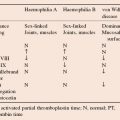Lymphocytes (Fig. 4.1) are an essential component of the immune response and are derived from haemopoietic stem cells. A common lymphoid stem cell gives rise to daughter cells which undergo differentiation and proliferation (Fig. 4.2).
Lymphocyte maturation occurs principally in bone marrow for B cells and in the thymus for T cells, but also involves the lymph nodes, liver, spleen and other parts of the reticuloendothelial system. B cells mediate humoral or antibody-mediated immunity while T cells are responsible for cell-mediated immunity. Lymphocytes can be characterized on the basis of the antigens expressed on the surface of the cell (Table 4.1). These differ according to the lineage and level of maturity of the cell. The cluster of differentiation (CD) nomenclature system has evolved as a means of classifying these antigens according to their reaction with monoclonal antibodies (see Appendix). Lymphocytes have the longest lifespan of any leucocyte, some (e.g. ‘memory’ B cells) living for many years.






